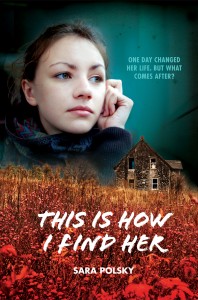Welcome to Craft Talk Tuesday. Today, we’re the last stop on the Sara Squared Blog Tour. The Writing Barn we welcome Sara Polsky, debut author of This is How I Find Her (Albert Whitman). Kirkus says, “This quiet novel provides honest insight about the conflicting emotions felt by families struggling with bipolar disorder. Sophie’s inner journey from resignation to hopefulness is authentically portrayed and will provide great comfort to any teen contending with a parent’s affliction. Perceptive and sincere.”
Sara joins us to discuss her research of bi-polar disorder and how it shapes the world of her story. Welcome, Sara.
 This Is How I Find Her, my debut YA novel, is about the effects of a mother’s bipolar disorder on 16-year-old Sophie and her extended family. The characters came to me first, but a strong sense of characters’ personalities wasn’t enough for me to plunge into a novel dealing with mental illness. I wanted to get the medicine right, too.
This Is How I Find Her, my debut YA novel, is about the effects of a mother’s bipolar disorder on 16-year-old Sophie and her extended family. The characters came to me first, but a strong sense of characters’ personalities wasn’t enough for me to plunge into a novel dealing with mental illness. I wanted to get the medicine right, too.
In researching the novel, I had two goals: first, to figure out what Sophie’s mother’s mental illness would mean for the characters emotionally, and second, to get the technical details of bipolar disorder as correct as I possibly could. Then, of course, there was the challenge of weaving everything I’d learned into the story in a way that didn’t dump information on the reader.
To make sure I had the emotional aspects of the story right, I turned to memoirs by people who had experienced mental illness themselves or witnessed the mental illnesses of loved ones. An Unquiet Mind, by Kay Redfield Jamison, showed me what it might be like to have bipolar disorder, and William Styron’s Darkness Visible taught me about living with depression. Laura M. Flynn’s Swallow the Ocean, a memoir about her mother’s schizophrenia, helped me figure out how Sophie’s mother’s mental illness might shape her personality and her life.
Reading these memoirs helped me get to know my characters, but the books didn’t give me all of the specifics I needed for a believable story. What medications would Sophie’s mother, Amy, need to take? How long might her manic and depressive cycles last, and how long would she stay in the hospital after her suicide attempt? What would her treatment options be once she left the hospital? To  answer these and other questions, I turned to some of the books about bipolar disorder meant for patients and their families, like Bipolar Disorder: A Guide for Patients and Families, by Francis Mark Mondimore, and The Bipolar Disorder Answer Book, by Charles Atkins. I took notes on medications, hospitalizations, and other details, and then I gave Amy the set of treatments that fit best with the story, which involved Sophie moving in with other relatives for several weeks.
answer these and other questions, I turned to some of the books about bipolar disorder meant for patients and their families, like Bipolar Disorder: A Guide for Patients and Families, by Francis Mark Mondimore, and The Bipolar Disorder Answer Book, by Charles Atkins. I took notes on medications, hospitalizations, and other details, and then I gave Amy the set of treatments that fit best with the story, which involved Sophie moving in with other relatives for several weeks.
Once I’d done the research, the next challenge was finding a way to fit it into the story where necessary. The fact that Sophie’s mother is hospitalized, and that Sophie, as her caregiver, goes to the hospital to check on her, gave me one way to weave in information: Sophie’s conversations with her mother’s doctor. In one scene, for example, the doctor explains to Sophie that once her mother stopped taking her medication, “she entered what’s called a mixed state, where patients experience both manic behavior and depression. Mixed states can be particularly dangerous, because individuals not only often have suicidal thoughts, but also have the energy to carry them out.” That information came from my research, and it fit naturally into a conversation between doctor and caregiver.
A reader of an early draft also pointed out that Sophie, having taken care of her mother with no help for several years before the story begins, would probably be something of an expert on her mother’s situation. So I gave some of the information I’d learned in my reading to Sophie, who is able to confidently recite to her relatives and her mother’s doctor information about her mother’s medications and habits.
Sophie’s focus on caring for her mother, though, presented another challenge for me as a writer: when the book begins, Sophie is detached and isolated, with no close friends or confidantes. Until Sophie starts to connect with people, the reader is stuck in her head, so without a lot of dialogue and interaction to keep the story moving, I had to make Sophie’s head an interesting place to be. She is an artist, which allowed me to play with imagery and description in the way Sophie observes her world. I also turned to flashbacks to show Sophie interacting with her extended family — and unraveling the mystery of the estrangement that left Sophie alone with her mother for so long — and to help Sophie remember the close relationship she has with her mother apart from being her caregiver. Ultimately, balancing research and story meant turning to writerly nuts-and-bolts: language, description, character, and voice.
Sara Polsky is a writer and editor living in New York City. Her debut novel, THIS IS HOW I FIND HER, is on shelves now. Visit her at her website (www.sarapolsky.com), on Twitter (@sarapolsky), and on Goodreads (http://www.goodreads.com/author/show/6993332.Sara_Polsky) and Facebook (https://www.facebook.com/polskysara).


